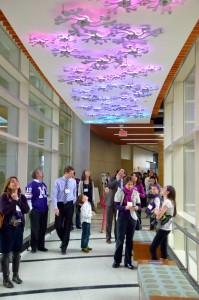by Erin O’Brien

Source: Anne Giroux
Lily Giroux is a 20-year-old freshman at the University of Iowa whose relationship to the University of Wisconsin-Madison is so concrete that not even a Big 10 Conference rivalry could sever it. Why is that? The reason is because Lily’s connection to UW-Madison lies within the Wisconsin Idea. Lily, a Madison native, has lived with epilepsy since she was a toddler and is greatly impacted by epilepsy research at UW-Madison.
Lily is the inspiration behind Lily’s Fund for Epilepsy Research, a grassroots organization founded by Anne and Dave Giroux, Lily’s parents, in 2007. The family was so impressed by the cutting edge epilepsy research UW-Madison was involved in at the time that they made a donation to the school’s research. This was the beginning of the now fully encompassing epilepsy organization that raises awareness and funds epilepsy research at UW-Madison. This organization and its relationship to the university embrace the goals of the Wisconsin Idea. Through Lily’s Fund’s backing of UW-Madison epilepsy research, the university is able to extend its influence beyond their research labs and into the lives of Madison and Wisconsin’s epilepsy community.
“Madison as a whole loves and interacts and depends on the university,” Anne Giroux said.
This is one of the reasons why Anne and Dave Giroux felt very strongly about entrusting both their money and faith into UW-Madison’s epilepsy research, as they are also both UW-Madison alumni and live just a few miles from the university.
“We don’t want to start something new, we want to support and beef up what’s existing,” Giroux said. “So we felt very strongly that as a community, as a family, we wanted to support our UW.”

Source: facebook.com/lilysfund
A small family donation then turned into the first annual Lily’s Luau in 2009, an annual dinner and auction event fundraiser held at Memorial Union, to raise money for epilepsy research at UW-Madison. Awareness about the organization grew exponentially from there. From raising $16,000 at the first Luau to raising $145,000 at this past year’s Luau, held at Varsity Hall in Union South, the financial success of Lily’s Fund and their ability to provide research funding across campus has proven that they live and breathe the Wisconsin Idea, according to Giroux.
To date, Lily’s Fund has created three individual funding projects in order to support epilepsy research projects happening across campus. Lily’s Fund Fellows, Grace Grants and the Special Spark Grant are the research projects that are currently underwritten by Lily’s Fund at UW-Madison.
Lily’s Fund Fellows are selected young researchers at the university whose fellowship is funded by the organization in order to encourage young scientists to dedicate their research to epilepsy, as it is commonly an underfunded area of study, according to Lily’s Fund’s website.
Brandon Wright, a PhD candidate at UW-Madison, was the 2013 Lily’s Fund Fellow recipient. While working in a neuroscience lab on campus, Wright’s research was focused on understanding circuitry in a part of the brain called the hippocampus and understanding how electrical events play out in the brain.
“[Lily’s Fund] definitely supported me in this work,” Wright said. “Without the fellowship I wouldn’t have been able to even focus on this project, so I’m thankful for that.”
Giving PhD students and established scientists across campus the opportunity to participate in epilepsy research is what makes Lily’s Fund unique in the way that they bring the Wisconsin Idea full circle.
“This is very much a: we give research money to you, you give back to us,” Giroux said. “To me [Lily’s Fund] just completely embodies the Wisconsin Idea.”
Not only in the mission of the organization but physically on campus as well, Lily’s Fund

Source: facebook.com/lilysfund
literally leads the university towards findings a cure for epilepsy with their creation of The Neuron Project; a hallway located in the Wisconsin Institutes of Medical Research (WIMR) that is lit by illuminating neurons on the ceiling which can be bought as donations to the organization. Proceeds from The Neuron Project go directly to Lily’s Fund to continue to underwrite epilepsy research at UW-Madison. The most encompassing bit of this project is that the hallway in which the project is located leads visitors directly into the Neuroscience Department where a lot of the cutting edge epilepsy research on campus is currently taking place.
“We committed to have a [$10,000] neuron on the 5th floor of WIMR that says Sigma Alpha Epsilon,” Lucas Fass said, a UW-Madison senior and former Philanthropy Chair of the Sigma Alpha Epsilon campus fraternity. “That’s probably one of my biggest accomplishments in college is getting to have that.”
Lily’s Fund provides UW-Madison students like Fass and Wright opportunities to channel skills that they’ve acquired at the university and practice them in rewarding ways that benefit the greater epilepsy community in Wisconsin, which is what the Wisconsin Idea is all about.

Fass and the rest of the Sigma Alpha Epsilon fraternity support Lily’s Fund as their annual philanthropy partnership. Since establishing this partnership in 2009, the fraternity has worked to extend the scope of epilepsy awareness to the student population on campus.
“Naturally we are supporting Lily’s Fund’s ideas through our financial support,” Fass said. “So together we’re just raising awareness among students for epilepsy.”
Amidst all of Lily’s Fund’s financial success, it is to no one’s surprise that the organization has also successfully found ways to continually raise awareness about epilepsy.
Last November, Lily’s Fund and the UW Athletic Department teamed up to raise awareness about epilepsy for the Badger football game against the University of Minnesota. Choosing this game to show support for the Minnesota football coach Jerry Kill who has epilepsy, Lily’s Fund and the Badgers created an atmosphere around the stadium to promote National Epilepsy Awareness Month and to show further support for the 1 in 26 people who will live with epilepsy in their lifetime.

“It just made sense because all of this research is happening here, this is our team, these are our labs, these are our researchers, we’re all in this together,” Giroux said. “Everything came full circle and it was an incredible outpouring of red and white and purple.”
With purple being the color for epilepsy awareness the stadium that day then erupted in waves of purple. Lily’s Fund gave all players purple 1 in 26 stickers to wear on their helmets, the coaching staff wore purple, the student section was given purple Lily’s Fund bandanas, banners wrapped around the stadium with epilepsy information and 80,000 people watched a video sponsored by Lily’s Fund about epilepsy. All the while, a major rivalry football game was going on at the center of the day.
“The Gophers got on board too,” Giroux said. “What a rivalry, a huge rivalry that has gone on for decades and they came together on this. That’s pretty cool.”
Social media responses from the football game showed the immediate impact that Lily’s Fund made in the epilepsy community throughout Wisconsin and Minnesota. Giroux says that they have already seen increased epilepsy awareness ever since the football game. Badger alumni living with epilepsy also reached out to the organization, applauding them for the event and the work that they do.
The Madison community is also applauding Lily’s Fund and not just after game days in Madison. Volunteers and members of the community who are affected by epilepsy and Lily’s Fund know how special the organization is and how passionate they are about what they do, and it does not go unappreciated.
“Lily’s Fund really goes out of their way to make sure that people who have participated in their fundraisers see where the money is going,” Connie Chesnik said, a Madison attorney and Lily’s Fund volunteer. “You really do get to see the difference [you’re making].”
Appreciation for Lily’s Fund comes with a community appreciation for UW-Madison as well. Not only does the Madison and epilepsy community hold the university in high regards, but the research being done at UW-Madison also has the opportunity to greatly affect their lives because of the Wisconsin Idea and Lily’s Fund.
“I think people are just proud of this institution,” Chesnik said. “I think the cure for this disease is going to be found here.”
By Erin O’Brien.
For more on this topic, click here.
